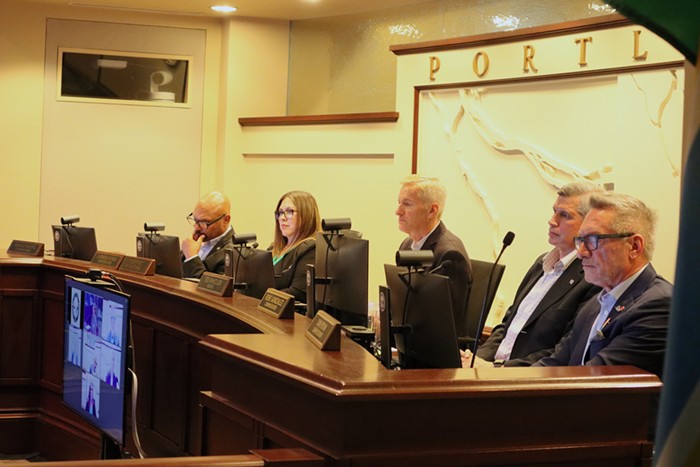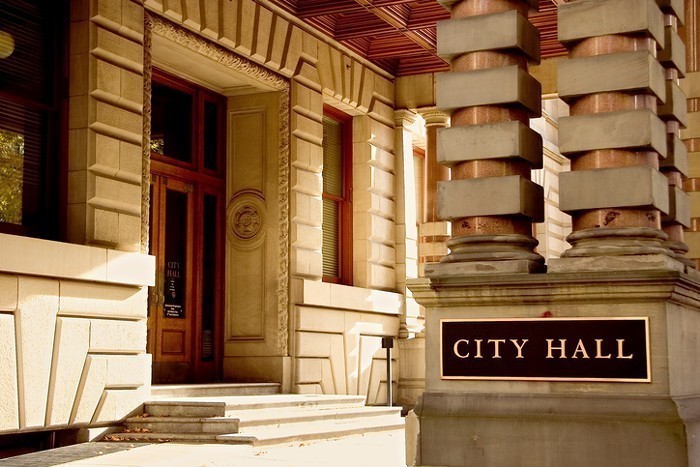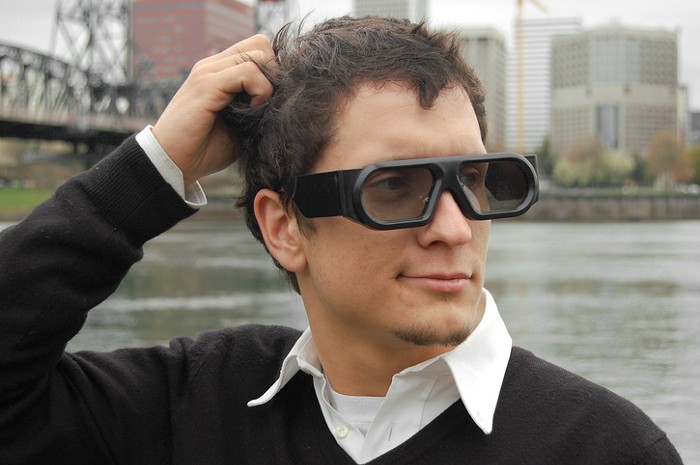BILLY BONES is wearing very little clothing. He and about 70 other skateboarders are about to race down Mount Tabor at 35 miles per hour or so. That sounds slow for people used to driving, but he won't be in a warm, steel-enclosed box, but standing in the wind on a set of wheels screwed to a pathetic chunk of wood. For this, Bones (born Billy Meiners) is wearing a white helmet painted like a golden-toothed skull, and gloves detailed with bones−but the rest of his tender flesh is only covered with thin, skin-tight fabric. It's a great outfit for aerodynamics, but it's a "fuck you" to the road-rash gods.
Nearby, other skaters sport similar attire: full-face helmets fashionably paired with nothing but tiny shorts that flap as they speed down the side of Mt. Tabor.
There are three things that would have been weird about this scene 10 years ago, but the guys' skimpy clothes aren't one of them.
The first weird thing is that Meiners and friends are racing downhill on longboards. Until the late '90s, downhill was an oddball niche in the skating world. Downhill skaters don't do crazy jumps or tricks. They mostly just skate really, really fast. Watching them skate is like watching a NASCAR race with fewer bikinis and flames. But recently the sport has exploded worldwide−especially in Portland, which longboarders agree has one of the best downhill scenes on earth.
The second weird thing is that every single one of these 70 skaters is wearing a helmet. While mainstream street skating blows off safety gear as uncool stuff for old folks, helmets are encouraged among the most respected downhill skaters, in part because of the neurological stakes of a wipeout at 40, 50, or 60 MPH.
The third weird thing is that this race is completely legal. Permitted downhill races are rare and this−the second annual Mount Tabor Downhill Challenge−is happening with the city's blessing just three days before Portland City Council will weigh in on an ordinance that would ban skating on 10 of skaters' favorite streets in the city.
The proposed ban highlights how downhill skating in Portland is now at a crossroads. As the sport grows, skaters can become a safer, more responsible community that works with the city, acquiring permits and encouraging crackdowns on skaters who break laws and piss off neighbors. But there will always be an element who thinks skating is better off without rules, that helmets are for wussies, and that minivans make thrilling obstacles. Who will define Portland's laws around skateboarding: The relatively upstanding citizen skaters, or the rogues?
***
Portland has always been good to skateboarders. In 2000, while other cities around the country were freaking out about the youth skating menace, then-City Commissioner Charlie Hales pushed city council to formally legalize skating on all city streets (except the transit mall) as a legitimate form of transportation. We have marked "skate routes" downtown—including both skateboards and a laughably dated rollerblade graphic—and the head of the Portland Bureau of Transportation (PBOT), Tom Miller, appeared in a Wall Street Journal profile proudly holding his scratched-up board. The only world championship downhill race in America is held just a few hours outside of Portland, in Goldendale, Washington, every summer.
"Portland is one of the best longboarding scenes in the world," says Michael Brooke, who has run longboarding magazine Concrete Wave for 11 years. "It comes down to people and geography. There's a real good group of core skaters who are supporting the scene and a few really good shops. And there's some pretty good hills."
Some of those pretty good hills happen to cut through the ritzy Arlington Heights neighborhood. West Hills residents have lived for a decade with large groups of Zoobombers zooming through the area on Sunday nights, but downhill skaters hit the area's steep, winding streets pretty much every sunny day. The city's proposed ban would make skating illegal on streets like SW Kingston and SW Fairview, but leave a "transportation route" through the park. It also quadruples fines for infractions like running stop signs and not wearing a helmet if you're under 16.
"We're really, really afraid someone is going to die on our streets. The situation in the last few years has gotten completely out of control," skateboard ban proponent Eric Nagle told city council at its June 27 hearing on the plan, during a presentation he titled "Tempting Fate." "Our entire neighborhood has become a de facto skatepark."
Other neighbors recounted stories of skaters accidentally crashing into their car—breaking the windshield—and, worse, crashing into their three-year-old. Meanwhile, the police have handed out zero citations in the past year to skaters in the area.
Resident Mark Mozden wore his pilot's uniform to the hearing, telling council he was fresh off a flight from Hong Kong, forgoing sleep to testify about being hassled by downhill skaters multiple times as he tried to drive to work recently.
"I don't think my company's customers in Luxembourg care about why one of their pilots is not able to get to the airport," said Mozden. "Why am I paying taxes to live in this neighborhood that I thought would be a great place?"
***
Meiners is 26, which makes him an old guy in the skate scene. He wears race gear that's hand-painted to resemble a dia de los muertos skeleton, but is the kind of death-defier who intimately understands the benefits of safety gear: Meiners holds the completely unofficial world record for fastest fall on a skateboard when he once ate shit at 78 MPH. Because he was wearing a full suit of leathers, helmet, and gloves—and because he is that breed of lucky and charismatic dude whose apparent invincibility is proof of an unfair world—he only stubbed a toe.
When Meiners and Rip City Skate shop manager JP Rowan started organizing informal downhill races in Washington Park a few years ago, maybe a dozen people would show up. At last count, their turnout was more like 100. In recent months, they've gone the route of getting permits for races and requiring all racers to wear helmets—something they learned from older Portland downhill skaters they respect.
"Some of us who got into downhill a couple years ago have had some really close calls. We try to let younger people know not to approach every run like it's your last," says Meiners.
Casey Morrow, 25, is a street-skater turned longboarder who is known for skating everything, everywhere. He didn't wear a helmet or care much about traffic laws when he got into downhill. But he's changed his ways.
"Honestly, I wasn't really for it initially. It feels really good to have the wind going through your hair. But after hearing a lot of horror stories about people dying, you know, you want to protect your community and not have people think you're a bunch of reckless assholes," says Morrow.
The rogue element, downhill skaters say, tends to be teenage skaters who don't really care about things like stop sign ordinances or the Portland skate community's relationship with neighbors. Unfortunately, they also have a habit of recording their wild runs and putting them on YouTube, where neighbors like Eric Nagle find them, get scared, and end up screening the videos for all of city council.
"It's unfortunate that the neighbors are using a few bad apples to make skating illegal for everyone. More and more people are starting to shape up and act right," says Meiners. "They don't understand skateboard culture. If it's illegal, then people's approach to skating will be different. Why be respectful if we're already breaking the law?"
Meiners and Rowan have done some crazy things in their lives. But they'd never been involved in city politics until last year, when they joined a group of Arlington Heights neighbors and representatives of four city bureaus—including the police—to try and solve the conflicts between cars and skaters. The neighbors quit participating in the meetings in the winter when Nagle accused Meiners of organizing an unpermitted skate race in the neighborhood. (Meiners says he wasn't involved and that other skaters organized the race.) The neighbors then went to Commissioner Randy Leonard's office for an outright ban.
Meanwhile, the group of skaters, bureaucrats, and police formed a surprisingly solid team and drafted up big plans for an alternative approach to safer skating: A joint education and enforcement campaign that would try to reform skate culture from within by publicizing skate laws and using occasional police stings to crack down on the rogues.
"It's not a lack of laws that's a problem. We have traffic laws," said Officer Hilary Scott at the group's most recent meeting. "I think that there's a perception [a ban] will be a magic pill, but it's not. We won't have any more resources, we will still have a million things to do that are a higher priority than skateboarding."
Originally set to launch in June, the campaign to launch a skate law website, print pamphlets, and erect signs on the hill was put on hold as the Leonard-backed ban headed to council.
***
Commissioner Leonard isn't a "Get off my lawn!" coot. He skated around Northeast Portland while growing up here in the '60s. When his son was young, Leonard drove him to skate spots around Portland.
"But I'd never take him up to the top of Fairview," says Leonard. "What parent would?"
His son, now 36, made his own opinion on the skate ban clear when he recently texted his dad a photo of himself, with his skateboard and safety gear, giving Leonard a big thumbs down.
Leonard, ever the patriarch, thinks there's just no safe way for most kids to skate the steep Southwest hills. The best thing to do is send a serious message that the city thinks skating the hill at all is an accident waiting to happen.
"It's not just blowing stop signs. You can be doing everything right, but you've got cars backing out of driveways, cars backing out of side streets. Does it take someone getting killed? Accidents happen in all sports, but this is a sport on the street. They're putting a lot of risk onto someone else," Leonard says.
It's not clear how unsafe it actually is to skate in the neighborhood. The limited data shows that crashes are relatively rare—well, at least ones bad enough to get reported are rare.
Skate crashes vanish in state and city data, where skateboards are lumped into awkward miscellaneous categories that also include pedestrians (in the city data) or wheelchairs, roller skates, and scooters (in the state data).
Leonard's office culled two years of 911 calls to match up calls with skate incidents neighbors reported to his office anecdotally. They turned up 12 calls to police for crashes in the West Hills that seem to have involved skaters. The average age of people involved in those 911-worthy calls is 19.
The state crash data shows 41 reported crashes involving that mishmash category of wheeled devices since the beginning of 2009, only one of which was a skateboarder in the Southwest hills—a whopper of a crash involving a 21-year-old male this past November.
As Cory Poole, a 34-year-old longboarder who showed up to testify against the ban at city council, said: "Has there ever been a law to exclude an entire class of vehicle from public roads based on a single recorded event?"
***
The two sides came to a head on the day of the skate ban hearing on June 27. Neighbors pushing a ban and skaters pushing for better education packed city council. It looked likely that Leonard would not have the votes to pass the ban−and so before public testimony even began, he made a motion to pause the vote until September, giving the upstanding citizen skaters a set time to implement the enforcement and education campaign. That's a clear victory for skaters, but now comes the hard work: seeing whether they can actually make it safe for hundreds of people to ride the contested Southwest streets this summer.
Eleven-year-old Laurelhurst student Emmet White was in city hall for his first time ever to watch the great skate debate with his dad. The tiny guy has been skating the West Hills roads for a couple months and says he follows the example of older downhill skaters like Billy Bones in always wearing a helmet.
"It's a lot better than getting brain damage," said White.
But he still sees kids out there who swerve around cars and don't wear safety gear. He has opinions about them, too:
"I think they're making a bad representation of our community."













